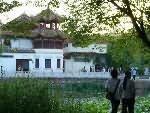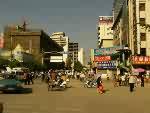- Getting around Lijiang. Dont stay in the Old Towns more than 2 days, there is nothing to do. KRISS Oct 9, 2013 05:46
- 2013 Beijing Temple Fair BENNYLAU Feb 26, 2013 03:29
- Malaysian traveling from KUL - LAX vis Shanghai PVG ZATI_DY Jan 3, 2013 20:15
Where Spring Does Not Fade
- Views: 3994
- |Vote: 0 0
- |Add to Favorites
- |Recommend to Friends
Generosity
The first time I made contact with Kunming soil was when I fell on it. After a 16 hour bus ride from the Chinese border, and having arrived in Kunming in the middle of the night, I made a miscalculation as to the height of the bus door and fell flat on my face in the middle of a group of taxi drivers urgently seeking fares from the passengers.
It was taken in good humour of course, and when I finally got to my feet and had endured the laughter and curiosity of the crowd that had gathered to watch the clumsy foreigner, I wasn't spared the usual sales pitch for a ride to any expensive hotel I might have been booked into. To be honest, I hadn't made any plans at all for my stay in Kunming, hadn't expected the bus would arrive so late, and was just hoping I could get to the nearest cheap traveller's hostel for a plain bunk and a chance to sleep. But it was to prove difficult. My ankle had been sprained badly and I had to limp my way out of the long distance bus station whilst carrying my heavy backpack. My luck with the hostels wasn't good either – none of them was prepared to risk taking on a foreign guest – and I was having trouble walking from rejection to rejection – and on top of that I was drastically low on cash and there wasn't a money machine in sight.
Fortunately, there was a hotel nearby that could accept foreign guests, and I hobbled towards it, just holding a vain hope that they would have a cheap enough room. I must have looked miserable standing at the reception desk, because even though they didn't have such a room, I was overheard by a young man who had been on the same bus as I had – and he must have felt generously sympathetic, because before I knew what was happening he'd upgraded the room he'd just ordered to a twin bed suite and was helping me to the elevator.
It was a complete surprise – the boy had told me on the bus that he was interning in a foreign trade business in Yunnan's Vietnam border city of Hekou, and on his way back to Shanghai. I didn't expect he'd be kind enough to let me share his room without hesitation. He'd heard that I wasn't carrying enough money to pay for a room and so promised to help me find a bank in the morning – and wouldn't hear of any promise to pay him back.
I've been told that China is about the only place in the world where this can happen. Ask directions in any city in China and you may well find yourself invited to dinner. I had a friend from England who was backpacking through China for six months and who stayed with a family for three days after casually asking the way when lost. The same traveller later visited America, interestingly enough, and was never given directions even once – most of the time when he approached a stranger, he was ignored!
Development
Kunming is occasionally given the enviable title of the City of Eternal Spring. This certainly has generated a lot of tourist interest in the city, as the reputation of being one of China's most pure, unpolluted and beautiful developed cities does create a lot of interest. Whether it's a fitting or deserved title is another issue, and it was certainly a question on my mind as I left the (highly recommended) San Yuan hotel the morning following my clumsy arrival to the city. I was in a location quite deep in the southern districts, and very close to the main train station, right at the bottom of the City's main North-South artery, Beijing Lu. I'd slept well in the hotel room generously made available for me the night before, and the only repayment I'd had to make for the favour was to invite my new friend for a good breakfast. But I had to admit that my initial impressions of the City of Eternal Spring weren't as wonderful as I'd expected.
China's developing quickly, and the momentum at which this is taking place is increasing every year, and is now stretching all over the country. Kunming, the capital of China's South-western province of Yunnan, is modernising at a phenomenal rate, and the sacrifice made for this is largely environmental. Down around the train station, a fervour of office tower and housing developments have stirred up a lot of dust, and in this part of the city, even Kunming's famously clear azure skies are hazy. Wandering North up the rather soily Beijing Lu, I tried to dismiss my first impressions of disappointment and set out for some of the attractions in the North.
Kunming is loosely arranged in a ring road pattern like Beijing, and the greenest parts of the map are in the city's North-eastern quarter, Hua Qu. It didn't seem like an impossible walk away, and figured that an extended stroll would give me a far greater chance to get to know Kunming better – but my ankle was hurting again and I had to settle for a bus. At least sitting down for a while gave me some moments to check out some tourist background information about Kunming.
Kunming City
Despite having a definitively poetic atmosphere, Kunming has always been regarded as a remote and uncivilised place. Perhaps it was this lack of regard from the central Chinese administrations that gave the city a chance to thrive in a truly favourable environment. The weather in Kunming is exceptional: It's close to the never-ending summer climates of South-east Asia and therefore warm, but high enough in altitude to escape the worst of the heat. Enjoying good weather all year round, settlers in Kunming had found a clean and pleasurable home well-placed for trade with neighbouring countries. It is prosperous, relaxed, and for tourists, an ideal place to base yourself for further explorations deeper into Yunnan – home to a large proportion of China's ethnic minorities, scattered about the jungles and mountains and other remote terrains throughout the province.
The city has been an important trade centre for China for two thousand years. Trade routes between China and South-east Asia historically converged on Kunming, and these routes became important foundations for foreign interests in South China early in the 20th century. The French completed a railroad from Kunming into Haiphong, Vietnam in 1910, and began earnest trade with China, stimulating the economic growth of the city – and the British built the famous Burma Road in 1938, connecting Kunming and Burmese Lashio over a distance of 910 Kilometres.
Further industrial development in more recent times has helped the city grow into a major economic centre, certainly the biggest in the region. Mining and engineering concerns have made many local Kunmingese wealthy, and the look of the city reflects this new-found affluence. My bus passed through several commercial centres in the central city, developed malls and shopping areas that wouldn't have looked out of place in any major international city were here, in a part of the world where such progressive developments are uncommon. As I headed farther north, I found that my concerns that the fabled beauty of Kunming had already vanished were incorrect – streets were clean and clear, and the city was beginning to take on a far more pleasant look.
Attractions
Already feeling much more enamoured towards Kunming, I got off my bus very close to the river that divides Kunming in two from top to bottom – the Panlong Jiang – and started to look around. I sat for a while in a beautiful public square at the riverside on Taoyuan Jie – locals were strolling along the pathways looking over the remarkably clear river water that reflected the high-rises of the central city in sharp definition.
Crossing over the bridge onto Yuantong Jie, I arrived at one of the most important Buddhist sites in all of Yunnan province – the Yuantong temple. The temple costs just 4RMB to visit and backs onto the Kunming Zoo. It was built an astonishing 1200 years ago, back when Yunnan was not yet formally under Chinese administration and was a separate state called Nanzhao. The temple is also noteworthy in that it is the only known Buddhist temple built on a downwards slope. The area around the temple is perfect for travellers with an interest in Buddhism, and there are several vegetarian restaurants on the street.
Another short walk away is Kunming's most attractive park and lake area, Cuihu Gongyuan. A large and elaborate network of waterways and winding paths, Cuihu park is a relaxing and beautiful hideaway with broad, lotus-covered pools and overhanging willows. Many locals and visitors to the city were wandering around the lazy lanes; in various corners, small groups of Chinese musicians drew wistful melodies from ancient instruments. I sat listening and enjoying the mood – a peaceful reverie that many travellers have come to associate with Kunming, the peaceful capital of the South.







 Copyright © 1998-2025 All rights reserved.
Copyright © 1998-2025 All rights reserved.
1.
Mar 15, 2007 19:36 Reply
WINDENERGY said:
Mishen,
I am glad that your clumsy arrival and first impressions of Kunming vanished as you headed north of the main city. I don't think I'll head south on Beijing Lu, unless I'm passing through to see the Stone Forest. Kunming sounds like a fascinating City, I can't wait to see it myself.
You have alsorecently visited Wuhan in Hubei. I would venture to guess that Wuhan is farmore populated, polluted and traveller-unfriendly than Kunming. Sometimes, I wonder how it made it through 6 months living and teaching here. But, it was probably because of it being fall/winter, rather than spring/summer.
Anyhow, I plan to post an article about Kunming by the end of March. Maybe I'll make a comparative analysis of the differences between Kunming and Wuhan. That's all for now
__Breeze__